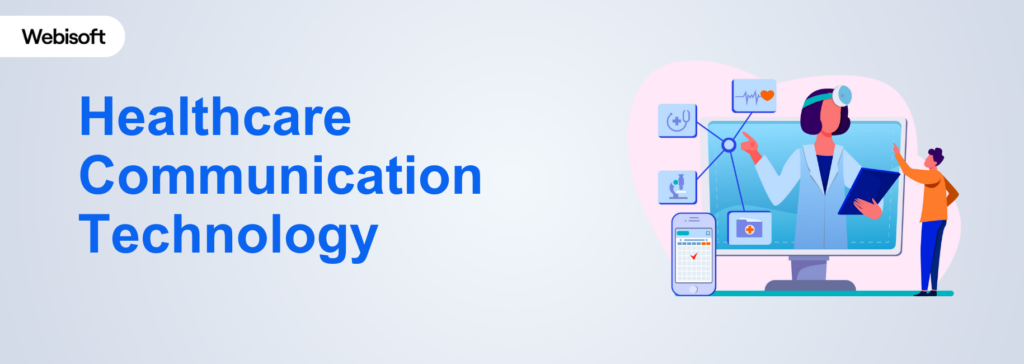Have you thought about how the latest healthcare communication technology is changing the way healthcare works? Nowadays, when it’s super important to be precise and quick, the way doctors and others talk to each other is changing a lot. This exploration is all about understanding how these new tools are reshaping communication in healthcare.
So, are you now thinking about the latest innovations in health communication technology?
Healthcare technology highlights include Electronic Health Records for centralized medical data, Telehealth offering remote consultations, E-Prescribing for digital prescription management, Blockchain-based Apps ensuring secure data exchange, and Remote Patient Monitoring for real-time health tracking.
In this article, we’ve discussed it with a better explanation. So, keep on reading, learn about them also discover how Webisoft can transform your healthcare communication experience
Contents
- 1 Overview of Healthcare Communication Technologies
- 2 5 Cutting-Edge Technologies for Effective Communication in Healthcare
- 3 Revolutionizing Healthcare Communications with Innovative Technology Solutions
- 3.1 The Role of Software-Defined Wide Area Network (SD-WAN) in Healthcare
- 3.2 Networking Simplified with Network as a Service (NaaS)
- 3.3 Beefing Up Network Security with Network Security as a Service (NSaaS)
- 3.4 Streamlining Communications with CCaaS
- 3.5 Unifying Communications with Unified Communications as a Service (UCaaS)
- 3.6 Enhancing Collaboration with Microsoft Teams and Cisco Webex
- 4 5 Reasons Why Healthcare Communication Technology is Essential
- 5 Effects of Poor Communication Among Healthcare Professionals
- 6 Empowering Patient Engagement: How it’s Done!
- 7 Cybersecurity Challenges in Healthcare Communication
- 8 Overcoming Challenges and Ensuring Success in Healthcare Communication Technology
- 9 Best Practices for Healthcare Communication Technology
- 10 Bottom Line
- 11 FAQs
- 11.1 Are there any specific regulations or guidelines governing healthcare communication technology?
- 11.2 Can healthcare communication technology help in reducing medical errors and improving patient safety?
- 11.3 How does telemedicine overcome limited healthcare access in rural areas?
- 11.4 How does AI enhance patient interactions in healthcare communication technology?
- 11.5 Does healthcare communication technology aid in remote monitoring and early detection?
Overview of Healthcare Communication Technologies
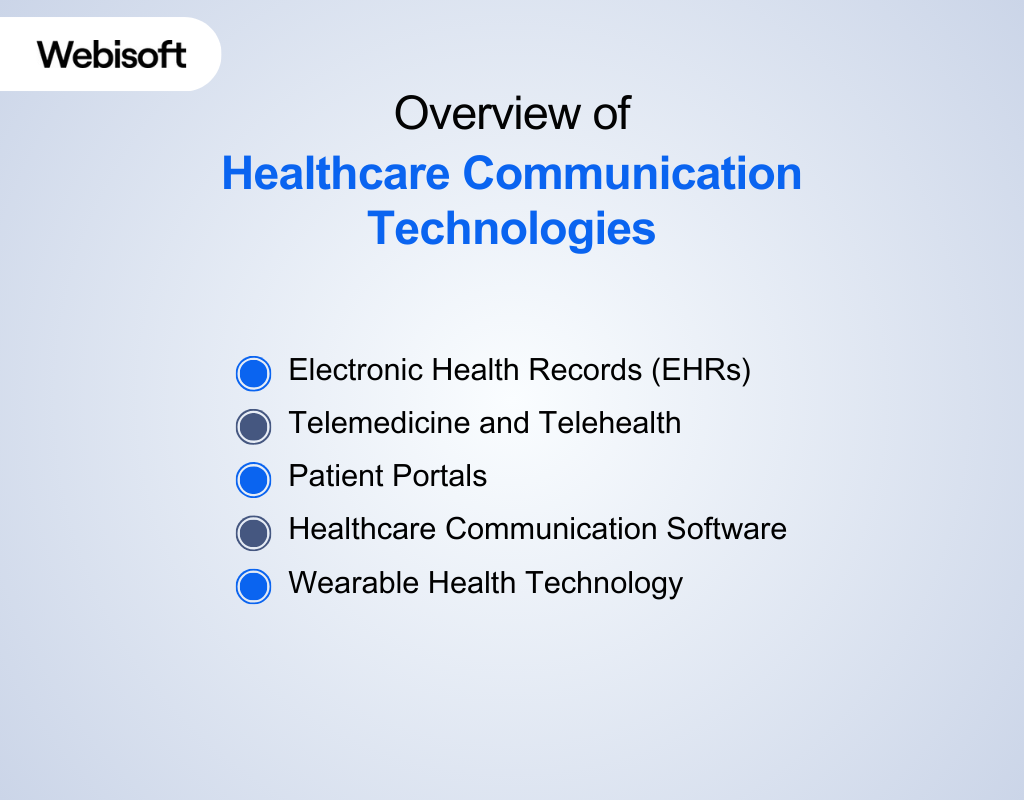
Healthcare communication technologies are transforming how we interact with healthcare systems. These technologies are revolutionizing patient care, from electronic health records to telehealth platforms.
Understanding these advancements is crucial for anyone exploring the healthcare system today.
Let’s explore an overview of these innovations and why they’re essential in modern healthcare.
Electronic Health Records (EHRs)
Electronic Health Records have changed the game in healthcare. They store your medical history digitally, making it easily accessible. This means less paperwork and more accuracy in your treatment.
EHRs ensure that your health information is just a click away from any healthcare provider you visit. They simplify your healthcare journey, making it more modernized and efficient.
Telemedicine and Telehealth
Telemedicine bridges the gap between you and healthcare providers. It allows you to consult with doctors remotely, saving time and effort.
This technology is especially beneficial for those with mobility issues or in remote areas. Telehealth services provide convenience, making healthcare more accessible than ever before.
Patient Portals
Patient portals give you direct access to your health information. You can schedule appointments, view test results, and communicate with healthcare providers.
These portals empower you with the tools to participate actively in your healthcare. Being informed and engaged in your health decisions leads to better outcomes.
Healthcare Communication Software
Healthcare communication software modernizes communication within healthcare facilities. It ensures everyone, from doctors to administrative staff, is on the same page.
These solutions reduce the chances of errors and improve overall efficiency in healthcare delivery. As a result, you receive more coordinated and effective care.
Wearable Health Technology
Wearable health technology monitors your health in real-time, like smartwatches and fitness trackers. They provide valuable data about your physical activity, heart rate, and more.
This information can be easily and thoroughly shared with healthcare providers for a comprehensive view of your health. Wearables encourage a proactive approach to health and wellness.
5 Cutting-Edge Technologies for Effective Communication in Healthcare
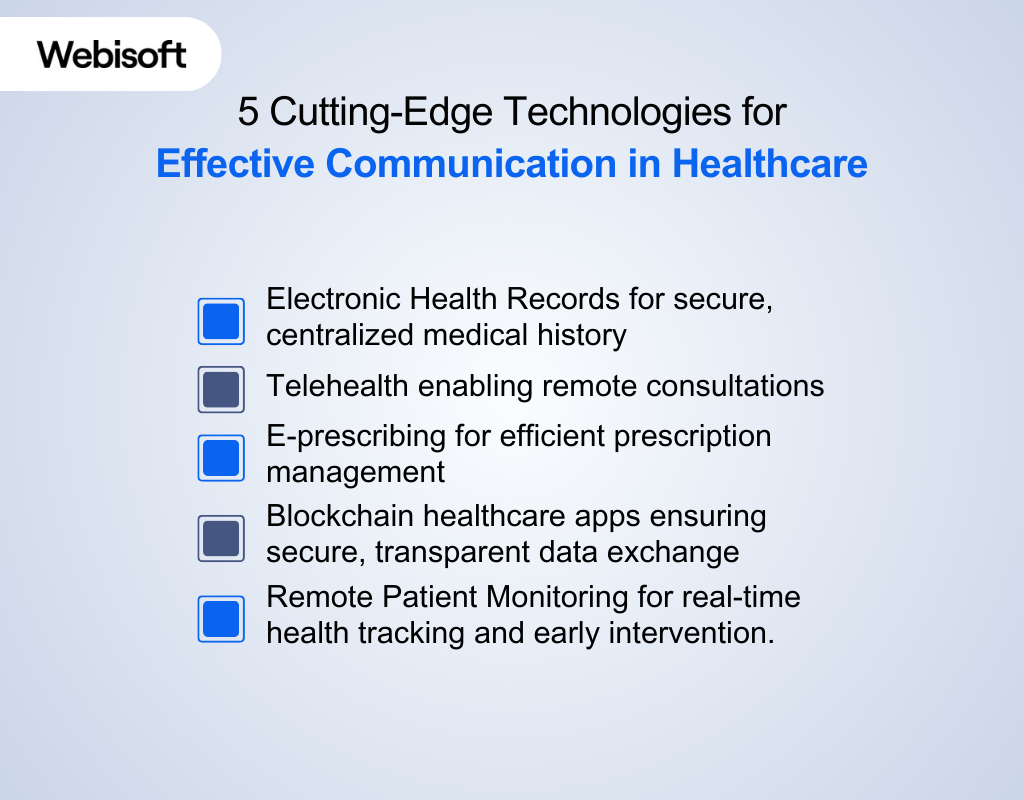
In healthcare, new communication technologies are revolutionizing how healthcare professionals connect, collaborate, and ensure effective patient care.
These innovative tools are designed to be user-friendly, portable, and customizable. They have the potential to transform healthcare communication technology.
In the following table, we move forward to exploring the features of five cutting-edge technologies. Let’s explore:
| Technology | Feature 1 | Feature 2 |
| Electronic Health Records (EHRs) | Centralized medical history storage | Enhanced data security and privacy |
| Telehealth | Remote patient-doctor consultations | Access to healthcare in remote areas |
| E-Prescribing | Digital prescription management | Reduced prescription errors |
| Blockchain-Based Healthcare Apps | Secure patient data exchange | Improved healthcare data transparency |
| Remote Patient Monitoring | Real-time health monitoring | Early detection of potential health issues |
Now, we will disclose each of the technologies in more detail. So, keep going!
1. Electronic Health Records (EHRs)
Electronic Health Records (EHRs) revolutionize healthcare by digitizing patient information. They provide seamless access to medical histories, diagnoses, medications, and more, ensuring efficient, coordinated care.
EHRs are pivotal in modernizing healthcare communication. They make patient data accessible and secure for healthcare professionals.
Key Features
- Limited Access: Only authorized providers to update and manage.
- Digital Format: Facilitates accessible data sharing across organizations.
- Seamless Information Sharing: Modernizes communication among healthcare professionals.
Pros
- Aids effective decision-making.
- Promotes timely medical interventions.
- Safeguards patient data.
- Saves time and cuts administrative tasks.
- Protects sensitive health information.
Cons
- Risk of system failures.
- Time-consuming to implement.
2. Telehealth
Telehealth, a rapidly changing technology in healthcare, offers remote medical consultations and treatments through telecommunications. This innovative approach includes video calls, phone calls, and chats, allowing patients to access healthcare from home.
Telehealth has become increasingly important, eliminating long wait times and bringing healthcare directly to patients.
Key Features
- Remote Consultations: Enables doctor-patient meetings via video or audio calls.
- Electronic Record Integration: Allows access to EMRs/EHRs for informed care.
- Digital Prescriptions: Facilitates prescription issuance and management online.
- Instant Communication: Provides channels for messages and instant chats.
- Secure Payment Integration: Ensures smooth, secure financial transactions.
Pros
- Easy, remote access to medical services.
- Instantly shares and manages patient data.
- Significantly lowers appointment wait periods.
- Rationalizes and secures payments.
Cons
- Requires reliable internet and devices.
- This may not suit all medical conditions.
3. E-Prescribing
E-prescribing, or Electronic Prescribing, revolutionizes how prescriptions are handled in healthcare.
This method allows doctors to send prescriptions electronically directly to pharmacies, enhancing communication and efficiency. It modernizes the prescription process, ensuring accuracy and better patient care.
Key Features
- Sends prescriptions straight to pharmacies.
- Connects with Electronic Health Records.
- Specifies exact dosage requirements.
- Access to patient’s insurance for affordable options.
- Ensures patient data protection.
Pros
- Saves time in prescription management.
- Reduces medication errors.
- Specifies precise dosages.
- Helps in choosing affordable medications.
- Build better relationships.
Cons
- Dependence on Technology: Requires reliable digital infrastructure.
- Learning Curve: Might need training for efficient use.
4. Blockchain-Based Healthcare Applications
Blockchain-based healthcare applications represent a significant leap in securing and managing medical data. These applications use blockchain technology for decentralized storage, ensuring enhanced security and communication.
They offer a revolutionary approach to handling medical information, with benefits including data integrity, privacy, and efficient data management.
Key Features
- Decentralization: No central authority controls the data.
- Immutability: Data, once saved, cannot be altered.
- Secure Cryptography: Protects information with cryptographic keys.
- Chronological Order: Arrange medical records in time-stamped order.
Pros
- Reduces risk of data breaches.
- Modernizes data access and decisions.
- Facilitates efficient record auditing.
- Gives patients control over data.
Cons
- Can be challenging to understand.
- Potentially high setup costs.
5. Remote Patient Monitoring
Remote patient monitoring (RPM) is transforming healthcare by enabling the monitoring of patients remotely.
Health data is collected at the patient’s location using digital technologies and securely transmitted to healthcare providers. RPM enhances communication, collaboration, and patient care efficiency.
Key Features
- Collaborative Communication Channels: Facilitates information exchange among healthcare professionals.
- Immediate Emergency Communication: Allows quick response in critical situations.
- Real-time Data Insights: Provides up-to-date health status information.
- Enhanced Patient Support: Offers continuous connectivity with healthcare providers.
Pros
- Easy and rarly detection of health issues.
- Reduces the need for frequent in-person visits.
- Encourages active participation in healthcare.
- Complies with HIPAA for patient data.
Cons
- Technology Dependence: Requires reliable digital infrastructure.
- Privacy Concerns: Potential risk of data breaches.
Revolutionizing Healthcare Communications with Innovative Technology Solutions
We’re living in an exciting time where technology is reshaping healthcare communications. Innovative technology solutions allow hospitals, clinics, and other healthcare providers to communicate and offer services more effectively.
The following table will provide an overview of various technologies reshaping healthcare communications, highlighting their features and benefits.
| Technology Type | Key Features | Benefits |
| Software-Defined Wide Area Network (SD-WAN) | Boosted Performance and Agility, Greater Bandwidth for IoT, Improved Real-Time Operations, Reduced Workload for IT Teams | Speedy, secure, and flexible connectivity for healthcare facilities operating multiple sites |
| Network as a Service (NaaS) | Savings on Costs, Top-Notch Security Measures, Lighter Load on IT Teams, Data-Driven Patient Care | Secure, compliant network with reduced complexity and cost |
| Network Security as a Service (NSaaS) | Enhanced Threat Prevention, Unified Security Policies, Compliance with Industry Standards, Lower Operating Expenses | Comprehensive security against cyber threats, ensuring compliance with data protection standards |
| Contact Center as a Service (CCaaS) | Quick Implementation, Insightful Reporting and Analytics, Support for Remote Work, Fewer Resource Dependencies | Improved patient care communication with efficient deployment and insightful data analysis |
| Unified Communications as a Service (UCaaS) | Secure Voice Services via Apps, Diverse Supplementary Features, Smooth Updates/Integrations, Centralized Collaboration System | Unified, secure communication platform for efficient patient data and interaction management |
| Collaboration with Microsoft Teams and Cisco Webex | Communication Tools for Voice and Chat, Easy Deployment, Hybrid Capabilities, Secure File Sharing and App Integration | Enhanced collaboration and efficient decision-making in healthcare teams |
So, let’s explore the role of these technologies and their advantages in detail:
The Role of Software-Defined Wide Area Network (SD-WAN) in Healthcare
Imagine a networking technology that uses software and cloud infrastructure to provide speedy, secure, and flexible connectivity across various healthcare facilities. That’s Software-Defined Wide Area Network (SD-WAN), and it’s a game-changer, especially for healthcare providers operating multiple facilities.
Let’s say you move to a cloud-based SD-WAN platform like VMware SD-WAN™. What could be the benefits?
- Boosted Performance and Agility: SD-WAN allows applications built for specific purposes to work seamlessly, improving healthcare services’ speed and efficiency.
- Greater Bandwidth for IoT and Data Analytics: With an increasing reliance on the Internet of Things (IoT) devices and data analytics in healthcare, the expanded bandwidth of SD-WAN ensures flawless data transmission and analysis.
- Improved Real-Time Operations: SD-WAN facilitates instantaneous communication and data sharing between healthcare professionals. It enhances teamwork and decision-making.
- Reduced Workload for IT Teams: The automation and efficiency provided by SD-WAN decrease the burden on IT teams, enabling them to concentrate on more crucial tasks.
Networking Simplified with Network as a Service (NaaS)
Network as a Service (NaaS) is a blessing for healthcare providers aiming to maintain a secure and compliant network without the associated cost and complexity. Think about solutions like Cisco Meraki NaaS services. What could they offer?
- Savings on Costs: NaaS solutions reduce the capital and operational costs associated with network maintenance and upgrades.
- Top-Notch Security Measures: NaaS providers implement stringent security precautions to shield healthcare networks from cyber threats and data breaches.
- Lighter Load on IT Teams: With NaaS, professional engineering support handles routine network management tasks, allowing IT teams to focus on strategic tasks.
- Data-Driven Patient Care: NaaS solutions use data analytics to identify patterns and trends, empowering better-informed care decisions.
Beefing Up Network Security with Network Security as a Service (NSaaS)
Network Security as a Service (NSaaS) is a must-have in the face of escalating cyber threats. You get comprehensive security and agility with solutions like CBTS NSaaS paired with VMware SASE and Check Point Harmony Connect.
- Enhanced Threat Prevention: NSaaS solutions apply advanced prevention measures to guard healthcare networks against cyberattacks.
- Unified Security Policies for All Users: NSaaS guarantees adherence to security policies by all users. It mitigates the unauthorized access or data breach risk.
- Compliance with Industry Standards: Healthcare organizations handle sensitive patient data, and NSaaS solutions ensure they meet industry regulations and data protection standards.
- Lower Operating Expenses: By outsourcing network security to NSaaS providers, healthcare organizations can save on infrastructure and personnel costs.
Streamlining Communications with CCaaS
Effective communication is at the heart of excellent patient care. Contact Center as a Service (CCaaS) solutions like the Five9 cloud contact center are packed with essential features to improve this vital aspect.
- Quick Implementation and Easy Maintenance: CCaaS solutions can be deployed swiftly and maintained effortlessly, reducing downtime and disruptions to communication services.
- Insightful Reporting and Analytics: CCaaS platforms offer invaluable data about call volumes, response times, and customer interactions, enabling healthcare providers to fine-tune their services.
- Support for Remote Work: CCaaS solutions offer healthcare organizations remote communication services, ensuring uninterrupted patient engagement.
- Fewer Resource Dependencies: CCaaS eliminates the need for on-premise hardware and dedicated IT staff, reducing operational expenses.
Unifying Communications with Unified Communications as a Service (UCaaS)
Interoperability challenges often hinder effective communication in healthcare systems. Unified Communications as a Service (UCaaS) solutions offer a unified and secure communication platform, like Cisco Hosted Enterprise UC and CBTS Hosted UC.
- Secure Voice Services via Collaboration Apps: UCaaS platforms use tools like Microsoft Teams and Cisco Webex, ensuring voice services are dependable and secure, even for hybrid and remote workers.
- Diverse Supplementary Features: UCaaS solutions offer features like instant messaging and file sharing, enabling seamless collaboration among healthcare professionals.
- Smooth Updates or Integrations: UCaaS platforms facilitate effortless transitions during system updates or integration with existing applications. It minimizes disruption to communication workflows.
- Centralized Collaboration System: UCaaS centralizes communication efforts. It allows healthcare providers to manage patient data and interactions on one secure cloud platform.
Enhancing Collaboration with Microsoft Teams and Cisco Webex
Interoperability obstacles can limit teamwork between healthcare professionals, obstructing the exchange of critical patient information. Solutions like Microsoft Teams and Cisco Webex offer strong collaboration capabilities.
- Communication Tools for Voice and Chat: Tools like Microsoft Teams and Cisco Webex facilitate voice and chat communication, allowing seamless interaction among healthcare teams, irrespective of their location.
- Easy Deployment and User-Friendly Experience: User-friendly collaboration platforms encourage adoption among healthcare professionals, supporting efficient and effective communication.
- Hybrid Capabilities: Collaboration solutions meet the needs of healthcare providers with hybrid work environments, facilitating seamless communication between on-site and remote staff.
- Secure File Sharing and App Integration: File-sharing capabilities in collaboration platforms enable healthcare professionals to exchange critical patient data. It promotes efficient decision-making securely.
5 Reasons Why Healthcare Communication Technology is Essential
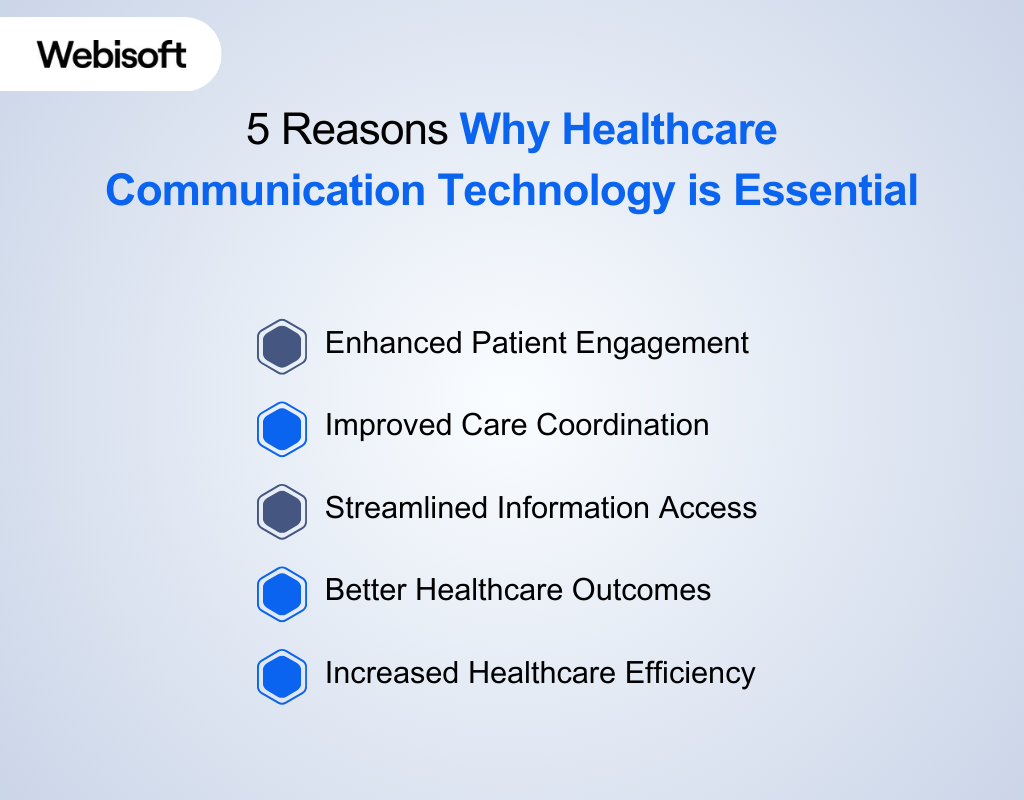
Exploring the importance of communication technology in healthcare, this article explores its vital role. Modern healthcare relies heavily on effective communication. With advancements in technology, communication has become more modernized.
Here, we’ll explore five key reasons why healthcare communication technology is essential.
Enhanced Patient Engagement
Healthcare communication software significantly boosts patient engagement. Understanding your health becomes easier when you have access to clear communication tools.
This technology allows for regular updates and reminders, keeping you informed. Patients feel more involved and in control of their health journey, leading to better outcomes.
Improved Care Coordination
Communication technologies in healthcare raise better care coordination. Seamless information flow among doctors, nurses, and other healthcare providers makes sure everyone is on the same page.
This coordination translates to faster, more accurate diagnoses and treatments. As a patient, you experience a more unified care approach.
Streamlined Information Access
Thanks to healthcare communication solutions, access to healthcare information has always been challenging.
These technologies enable quick recovery of your medical records and test results. The ease of access reduces waiting times and expedites decision-making processes. Consequently, you get timely and efficient care.
Better Healthcare Outcomes
One of the significant benefits of communication technology in healthcare is improved outcomes. With enhanced communication, miscommunications and errors are reduced significantly. This accuracy leads to better treatment plans and healthcare delivery.
Increased Healthcare Efficiency
Healthcare communication solutions pave the way for increased efficiency. By reducing paperwork and manual tasks, these technologies save time for healthcare providers.
This efficiency means more time for patient care and less on administrative tasks. Ultimately, you benefit from more focused and personalized care.
Effects of Poor Communication Among Healthcare Professionals
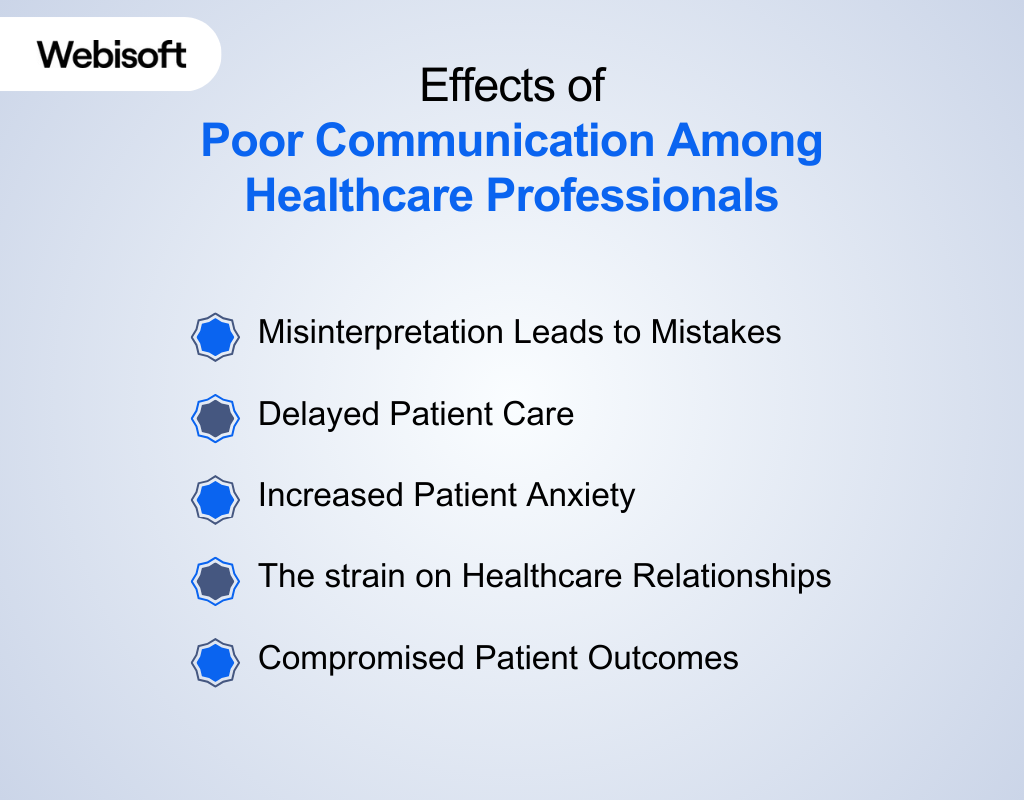
In healthcare, effective communication is vital. This article explores the consequences of poor communication among healthcare professionals. Understanding these effects helps in identifying the need for strong healthcare communication systems.
Let’s explore how inadequate communication can impact patient care and healthcare operations.
Misinterpretation Leads to Mistakes
Misunderstandings in healthcare settings can be dangerous. When messages are not clear, healthcare professionals might misinterpret vital information. This can lead to errors in medication, diagnoses, and treatment plans.
Imagine a nurse misunderstanding a doctor’s instructions, which could result in administering the wrong medication. Using simple, straightforward language and reliable healthcare communication platforms can minimize these risks.
Delayed Patient Care
Time is often of the essence in healthcare. Poor communication can cause delays in treatment. For instance, a lab technician needs to promptly relay test results due to efficient communication tools in healthcare to ensure a doctor’s response to a patient’s needs is timely.
Digital healthcare communications can modernize these processes, ensuring timely and effective patient care.
Increased Patient Anxiety
Patients rely on healthcare professionals for reassurance and information. When there’s a communication breakdown, it can heighten patient anxiety.
Unclear explanations or inconsistent information can leave patients uncertain about their health and treatment. A healthcare communication platform that facilitates clear and consistent messaging can lessen these concerns.
The strain on Healthcare Relationships
Trust is crucial in the healthcare setting. Poor communication can strain relationships between healthcare workers and between workers and patients.
For example, a doctor regularly providing incomplete information to a nurse can lead to frustration and mistrust. Using practical communication tools in healthcare can strengthen these essential relationships.
Compromised Patient Outcomes
Ultimately, the most significant impact of poor communication is on patient outcomes. Miscommunication can lead to incorrect treatments, missed diagnoses, and preventable complications.
By prioritizing effective healthcare communication, healthcare providers can significantly improve patient outcomes.
Empowering Patient Engagement: How it’s Done!
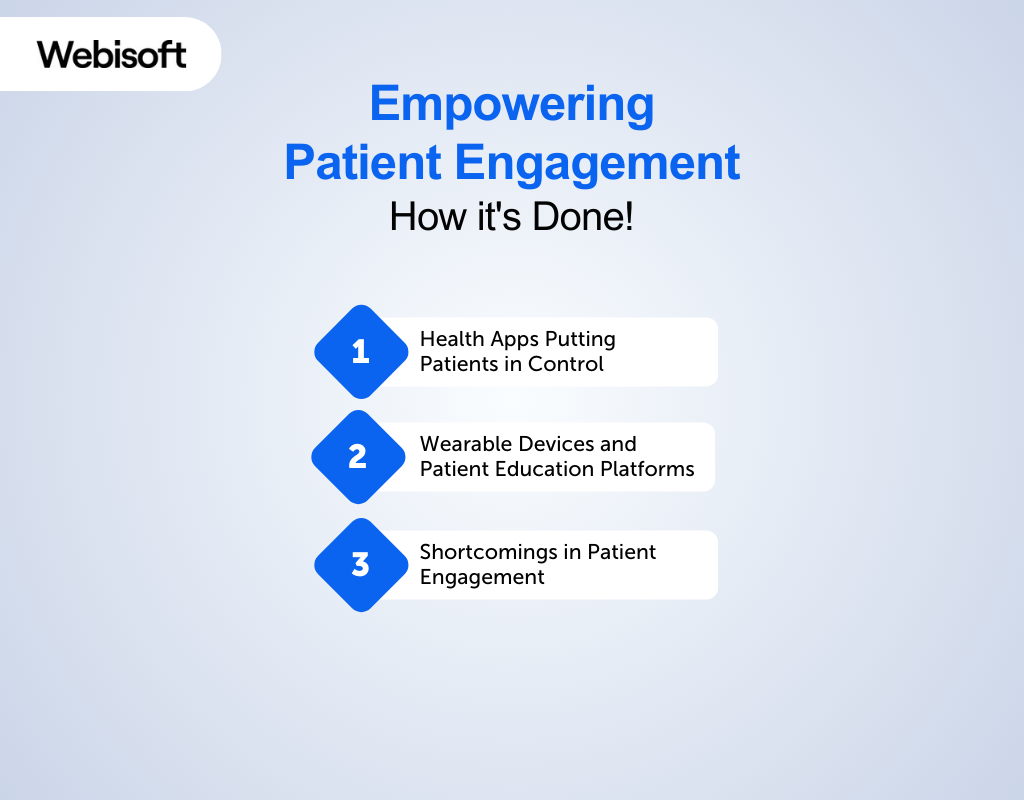
Healthcare communication technology is pivotal in empowering patients to participate in their healthcare journey. Patients can access information through various digital tools and platforms. They can communicate with healthcare providers and take charge of their well-being.
However, healthcare communication technology empowers patient engagement in the following ways:
1. Health Apps: Putting Patients in Control
One significant way technology empowers patients is through the use of health apps. These health apps provide different functionalities, from tracking symptoms and medications to offering personalized health recommendations.
By using health apps, patients can actively monitor their health status, set goals, and make informed decisions regarding their care.
2. Wearable Devices and Patient Education Platforms
In addition to health apps, wearable devices have become increasingly popular in empowering patient engagement. The devices enable individuals to monitor their physical activity, heart rate, sleep patterns, and other vital signs.
By collecting real-time data, wearable devices allow patients to gain insights into their health and make necessary lifestyle adjustments. Furthermore, patient education platforms provide valuable information and resources to patients.
These platforms offer interactive modules, videos, and educational materials, making healthcare information more accessible and engaging for patients.
3. Shortcomings in Patient Engagement
Healthcare communication technology offers tremendous potential for patient engagement. However, some challenges and considerations must be addressed.
One challenge is the digital divide, as not all patients enjoy equal access to technology or the necessary digital literacy. Efforts must be made to provide education and support for patients who may face barriers to using technology.
Additionally, privacy and security concerns arise when dealing with patient data on digital platforms. Safeguards must be in place to protect patient information and maintain confidentiality.
Cybersecurity Challenges in Healthcare Communication
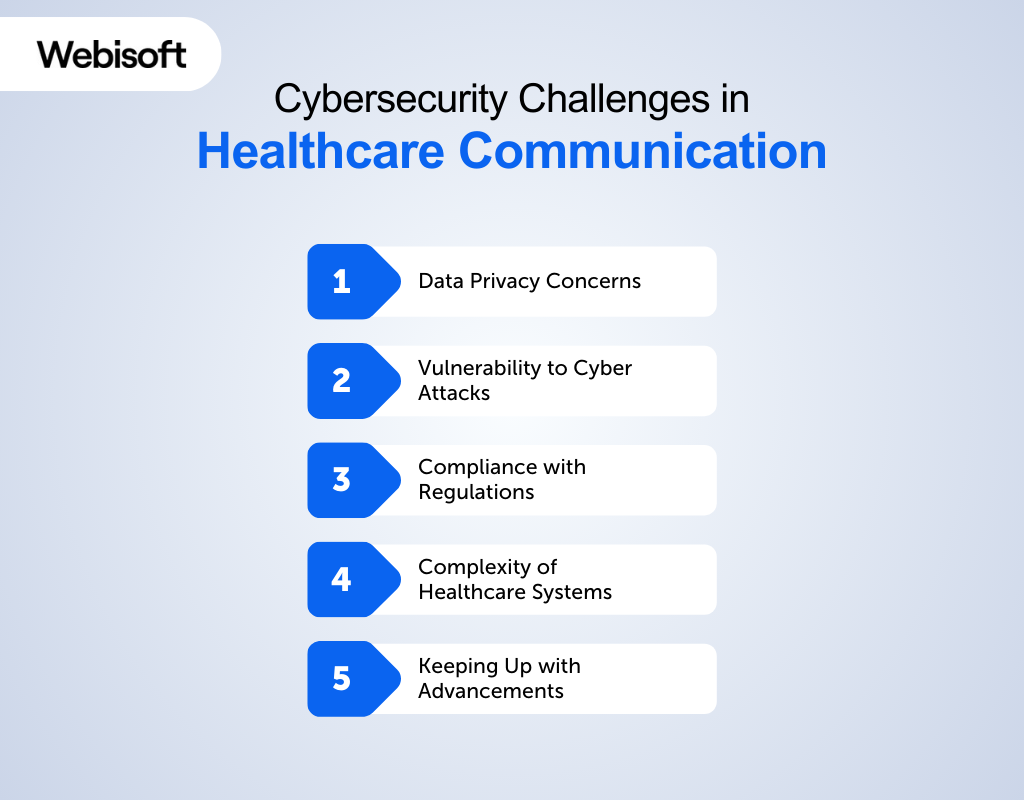
In healthcare, communication technologies have revolutionized how care is delivered. However, with these advancements come cybersecurity challenges that cannot be overlooked. Understanding the challenges is crucial as we rely more on digital solutions for healthcare communication.
The prime cybersecurity challenges include data privacy concerns, vulnerability to cyber attacks, healthcare system complexity, compliance with regulations, etc.
However, this section sheds light on the key cybersecurity issues in healthcare communication, ensuring you stay informed and vigilant.
Data Privacy Concerns
Your personal health information is sensitive and valuable. With healthcare communication software, the risk of data breaches escalates.
Hackers target these systems to steal your information. Safeguarding your data requires strong encryption and security protocols. It’s vital to know how your data is protected in these systems.
Vulnerability to Cyber Attacks
Healthcare communication solutions are not immune to cyber threats. Hospitals and clinics face the challenge of securing their networks against attacks. Ransomware, for instance, can cripple entire systems. Awareness and preparedness are essential. You should understand the potential risks and the steps taken for protection.
Compliance with Regulations
Healthcare providers must adhere to strict privacy laws, like HIPAA. Compliance is a challenge with growing communication technologies.
It ensures your data is handled correctly and securely. Providers need to update their systems and policies to stay compliant continuously. This adherence protects your information and maintains trust.
Complexity of Healthcare Systems
Modern healthcare systems are complex and interconnected. Integrating cybersecurity into these systems is a challenging task.
Every device, from computers to medical equipment, needs protection. Complexity increases the risk of vulnerabilities. Healthcare providers need to manage this complexity effectively.
Keeping Up with Advancements
Technology in healthcare is rapidly advancing. Keeping cybersecurity measures up-to-date is a constant challenge.
As new communication technologies emerge, so do new vulnerabilities. Healthcare providers must stay ahead of these advancements to protect their information. Continuous education and adaptation are essential.
Overcoming Challenges and Ensuring Success in Healthcare Communication Technology
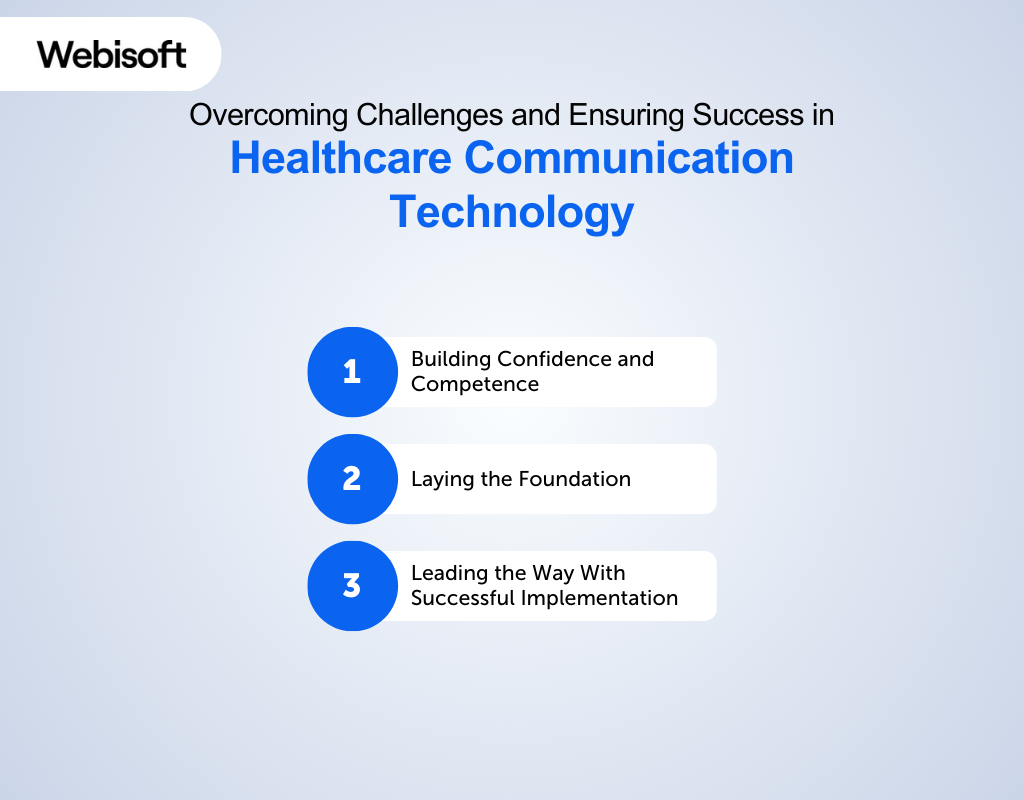
Implementing healthcare communication technology can come with various challenges. These must be addressed for successful adoption. Common challenges include resistance to change from healthcare professionals, limited resources for training and infrastructure, and concerns regarding data security and privacy.
However, to overcome challenges and ensure success in healthcare communication technology, follow the ways below:
1. Building Confidence and Competence
To overcome these challenges, you can implement several strategies. First, provide comprehensive training programs to healthcare professionals to familiarize them with the new technology and build their confidence in using it effectively.
This can include training sessions, workshops, and ongoing support to address any concerns or difficulties.
2. Laying the Foundation
Healthcare organizations must invest in their necessary infrastructure to support communication technology implementation. This may involve upgrading hardware, software, and networking systems to ensure seamless technology integration into existing workflows.
Also, data security and privacy should be prioritized. Implementing strong encryption methods, access controls, and regular audits can help safeguard patient information.
Compliance with relevant data protection regulations, such as HIPAA in the United States, is essential to maintain patient trust and ensure legal compliance
3. Leading the Way With Successful Implementation
Several healthcare organizations have successfully harnessed communication technology to improve connections and enhance patient care.
For example, Mayo Clinic implemented a secure messaging platform. It enables patients to easily communicate with their healthcare team. Ultimately, it results in improved patient satisfaction and modernized care coordination.
Another example is Cleveland Clinic’s use of telemedicine to reach patients in remote areas, providing them with access to specialized care that would otherwise be challenging. By using technology, Cleveland Clinic has expanded its reach and improved patient outcomes.
Best Practices for Healthcare Communication Technology
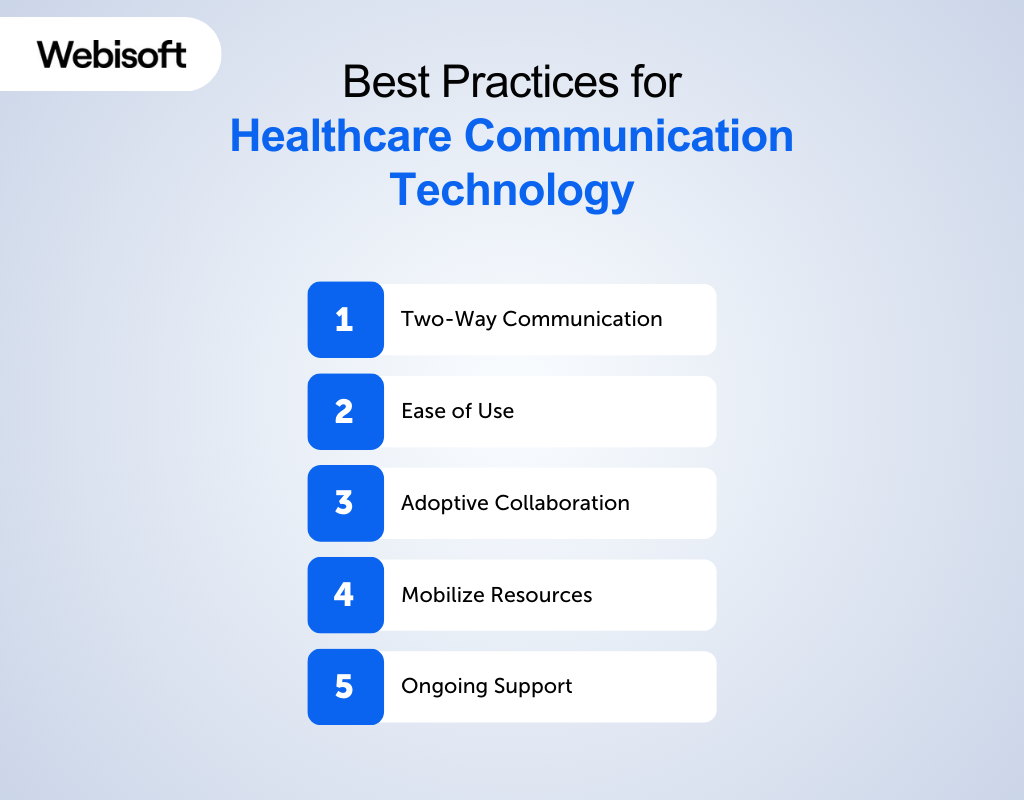
Are you ready to revolutionize healthcare communication with the best practices and cutting-edge technology from Webisoft? We understand the limitations faced by healthcare providers. And that’s why we’ve crafted innovative practices to make communication easy and efficient.
However, the best practices for healthcare technology are:
1. Two-Way Communication
Traditional hospital communication has often been one-way, leading to delays in patient care and staff distress.
Adopting communication platforms that offer two-way communication with responsiveness and accountability can enhance communication and teamwork among healthcare professionals.
Preset options in two-way communication tools can facilitate quick responses and ensure that messages are received and acknowledged promptly.
2. Ease of Use
Healthcare technology must be user-friendly and easily integrated into existing workflows to encourage adoption and minimize disruption to patient care.
A multi-modal solution that allows users to communicate through familiar technologies and devices will be more readily adopted by healthcare professionals.
Customizable interfaces and intuitive designs can help healthcare staff quickly adapt to new communication tools.
3. Adoptive Collaboration
True collaboration in healthcare requires empowering staff members to work at their highest capabilities and ensuring that all relevant input is considered in decision-making.
Communication technology designed to optimize hospital operations can facilitate teamwork and modernize repetitive tasks.
Pre-defined cross-disciplinary contact groups can enable quick assembly of appropriate teams for specific medical situations, promoting seamless collaboration.
4. Mobilize Resources
Care coordination in modern healthcare software development and settings can be complex, especially in emergency departments.
Communication tools can be used to share critical information between departments and ensure that the right resources are mobilized efficiently to improve patient outcomes.
Mobile communication devices allow nurses to call for support services, such as housekeeping or transportation, without leaving their posts, increasing efficiency in patient care.
5. Ongoing Support
Consistency is crucial when providing communication in a healthcare setting.
A cloud-based platform with 24/7 support can ensure that communications are always available and functioning correctly, reducing potential disruptions to patient care.
Continuous support ensures that healthcare staff can quickly address technical issues and receive assistance whenever needed.
Bottom Line
In summary, effective communication is critical in healthcare, not a mere convenience. It directly influences patient outcomes, and inefficiencies can lead to severe consequences, including medical errors and patient safety risks.
However, with the advent of technology, significant improvements have been made. Electronic medical records and advanced alarm systems enhance communication and patient care.
For healthcare institutes aiming to upgrade their communication systems, partnering with Webisoft is a strategic move. Their expertise in healthcare software development can modify solutions to your specific needs, improving communication and patient outcomes.
Ready to transform your healthcare communication technology? Contact Webisoft today for cutting-edge solutions that make a difference.
FAQs
Are there any specific regulations or guidelines governing healthcare communication technology?
Yes, specific regulations and guidelines govern the use of healthcare communication technology. For instance, in the USA, the Health Insurance Portability and Accountability Act (HIPAA) determines standards for protecting patients’ privacy and security when using electronic communication platforms in healthcare settings.
Can healthcare communication technology help in reducing medical errors and improving patient safety?
Healthcare communication technology can help reduce medical errors and improve patient safety. Through features such as electronic health records, real-time alerts, and secure messaging, healthcare providers can enhance information exchange, accuracy, and care coordination, leading to better patient outcomes and reduced errors.
How does telemedicine overcome limited healthcare access in rural areas?
Telemedicine overcomes limited healthcare access in rural areas by using communication technology to enable remote consultations and medical services.
Patients can connect with healthcare professionals remotely, receive diagnosis and treatment, access specialist expertise. And they can receive care without needing travel or proximity to healthcare facilities.
How does AI enhance patient interactions in healthcare communication technology?
AI enhances patient interactions in healthcare communication technology by enabling personalized and efficient interactions.
AI-powered chatbots can provide instant responses to patient inquiries. However, natural language processing allows for a better understanding and interpretation of patient input.
Does healthcare communication technology aid in remote monitoring and early detection?
Healthcare communication technology can assist in remote monitoring of chronic conditions and early detection of potential health issues. Through connected devices and remote monitoring platforms, healthcare providers can collect real-time data, track patient health parameters.
